This is quite a long-overdue entry actually, since we had this trip on last Friday. Haven't been feeling well over the past few days, and thus couldn't really find the energy to put up anything until today :P
Anyway, went to Semakau Landfill with Dr Dan, Dr Stan and their students from Duke University on Good Friday. Was rather happy to see Dr Dan again though I was struggling with a sore throat. It was always wonderful listening to Dr Dan as he shared his treasure trove of knowledge on the various marine organisms. I was their guide last year when they visited
Sisters Island and
Chek Jawa. This time round, however, I played the role of the coordinator for the trip, just to settle the boats and other logistics issues, while Ria had the pleasure of guiding him around the intertidal area of Semakau Landfill.

Here are our visitors from Duke University who just emerged from the secondary forest, getting ready to venture to the splendid shores of Semakau.

Semakau probably has the biggest seagrass meadow in Singapore. The seagrass meadow is an important nursery ground for many marine organisms, as there are lots of hiding places and food. Many of the seafood that we eat spend part of their life living among the seagrasses.

I was rather delighted to find this peacock anemone (
Order Ceriantharia) among the seagrasses, since they were less common on Semakau compared with our northern shores.

Other Cnidarians we saw include the pretty anemone coral (
Goniopora sp.) above and lots of other colonial hard corals. Each little flower-like structure you see above is called a polyp, and it is actually the coral animal! Colonial hard corals like this can sometimes have hundreds, if not thousands of polyps. The hard structure (or skeleton) you see is just like an "apartment" housing lots of little coral animals.

But sometimes, you get some lone rangers too, like the sunflower mushroom coral (
Heliofungia actiniformis) above. All the tentacles you see above belong to one single coral animal (aka polyp). It is called a mushroom coral because the juveniles are attached to the substrate on a stalk-like structure, making it look just like a little mushroom! The coral will break away from the stalk when it matures though.

Other than the hard corals, we have plenty of soft corals at Semakau as well. Not sure about the exact ID for this one though. Unlike hard corals which have hard skeletons made of calcium carbonate, soft corals have a soft tissue connecting all the polyps.
Semakau also has no lack of sea anemones, which are relatives of the corals (from the same Phylum Cnidaria) , including some of the larger ones like the gigantic carpet anemone (
Stichodactyla gigantea).

And sometimes, if we are lucky, we may even find the ocellaris clownfish (
Amphiprion ocellaris) in some of them. Are indeed, we were rather lucky. The one above, probably got disturbed by the sound made by my foot steps, actually jumped on top of the anemone as I was walking past. I didn't even have to look for it!
Clownfishes and anemones share an interesting relationship. While most other fishes will be stung by the anemone's stinging cells when they touch its tentacles, the clownfish has a layer of mucus over its body that prevented the anemone from discharging its lethal stings. The fish will help the anemone by luring prey to it, increasing oxygenation, removing waste material, and protect the anemone from some butterflyfishes which feed on the anemone, while the latter helps the fish by giving it protection from predators and leftover food.

We can usually see lots of fishes at Semakau, and sometimes, that includes fishes that don't really look like a fish, such as this tigertail seahorse (
Hippocampus comes). This was also the first time I saw this seahorse species at Semakau! Seahorse can usually camouflage themselves very well among the seaweeds, but guess this one's colour happened to more easily noticed :P

Another master of camouflage was this frogfish, probably a spotted-tail frogfish (
Lophiocharon trisignatus). It usually slowly creeps around on its special fins (which look like paws) and catches (with its big mouth) little fishes or other small animals which didn't see it coming.
Semakau is also a wonderful place to find echinoderms, like sea stars and sea cucumbers.

Just like our other trips, we found several common sea star (
Archaster typicus) before we enter the seagrass lagoon. These sea stars burrow into the sand to feed on any tiny edible organic particles.

At the rocky shore area, I was quite happy to find the cryptic rock stars (Cryptasterina sp.) again. These sea stars usually hide underneath rocks in the day away from the hot sun, and only come out to feed when it is darker. Can't remember what they feed on though. Probably algae, detritus or small clams?
Some of the others also found a few knobbly sea stars, which unfortunately I wasn't with them then to grab a few photos.
Fortunately, I managed to spot what I called the "Big Five" sea cucumbers of Semakau though.

One of the most common sea cucumbers on Semakau must be this - the sandfish (Holothuria scabra). This is usually the species that the Chinese eats during Chinese New Year, but they must be properly treated to remove the toxins before they can be consumed.

The second of the "Big Fives" - the stonefish sea cucumber (
Actinopyga lecanora). We can usually find it among the rocks near the coral reef.

This is an ocellated sea cucumber (
Stichopus ocellatus), which was only described in the 1990s! Sea cucumbers of this genus do not eject the sticky threads for defense, but they may eject their internal organs. When they are removed from the water for too long, they can actually "melt", become very limp and eventually disintegrate all together. However, if they are not too badly "melted", they are able to reverse this process and recover.

Also from the genus Stichopus is this dragonfish sea cucumber (
Stichopus horrens). Also called the peanutfish sometimes in the sea cucumber trade, or the thorny sea cucumber or horrible sea cucumber, this fellow sure goes by many names :)

And the last, but longest, of the "Big Fives" - the synaptid sea cucumber (
Family Synaptidae) .

But apart from the "Big Five", we had another surprise find - a red sea cucumber, which we thought could be an
Actinopyga sp. related to the stonefish sea cucumber. First time seeing this on Semakau actually, and we found several of them among the seagrasses.
Moving on to the mollusc, and yet another interesting group with lots of fascinating animals.

Found this pretty living heart cockle (Corculum cardissa) among the seagrasses. Sadly, some people collect this shell while it is still alive, kill it and make the shells into little gifts. To me, this is certainly a heartless way to make a so-called "token of love".

Among the seagrasses, I also found this pretty noble volute (
Cymbiola nobilis). These huge snails normally feed on clams and other shells. To feed, it wraps its prey in its huge foot, and waits until the exhausted clam opens up to breathe, which can take up to several days! The volute will then stick its proboscis into the shell and eats the flesh of its prey with its radula.
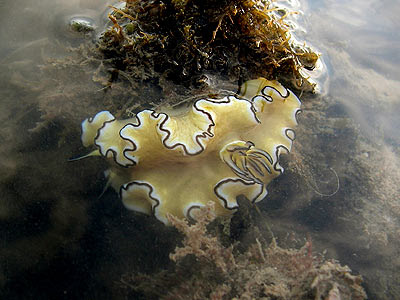
Also in the Phylum Mollusca, we have many beautiful little slugs called nudibranchs, and the above is one of them, a
Glossodoris atromarginata. They are closely related to sea snails like the volute above, and basically, they are snails without shells. The flower-like gills exposed on its back was what gives nudibranchs their common name. Nudibranch means naked gills!

Found this cute little polka dot nudibranch (
Jorunna funebris) on some seaweeds. The 2 little structures sticking out at its front end are its rhinophores, and nudibranchs use them to sniff out their prey. The polka dot nudibranchs are known to feed on blue sponges, so I was a little surprised when ST told me he saw one munching on some bryopsis seaweed! Could there be some tiny sponges growing on the seaweed? Or was it really eating the seaweed? I really have no idea...

We also saw a pair of
Chromodoris lineolata getting really intimate. However, the position didn't look quite right though. Nudibranchs are hermaphrodites, meaning they have both male and female reproductive organs. They often fertilise each other when they meet in a 69 position. These two, however, are not in the standard 69 position which allows mutual fertisilation. It is known that among nudibranchs, sometimes one will assume a male role and the other a female role, so I guess it's possible that the two slugs above could just be doing that. (
Update: Don't know what I was thinking when I wrote the above yesterday. The reproductive organs of the nudibranchs are always on their right side, so if they are facing the same direction side-by-side, their reproductive organs won't be able to meet, so they can't be mating here. So guess at the very most this could just be "foreplay", or they could be doing something else altogether.)

As it got darker, the slugs' distant relatives, the octopuses (
Order Octopoda), also started appearing. Octopuses are known to be one of the smartest invertebrates, if not the smartest.

We also found a few cluster of squid egg capsules. While octopus and cuttlefish eggs tend to look like bunches of grapes, squid eggs tend to look like (pardon the crude comparison) bundles of inflated condoms.
Enjoying the darker and cooler surrounding were also several flatworms (
Phylum Platyhelminthes).

And here's one of the commonly seen flatworms (
Acanthozoon sp.). Flatworms are so flat that they can easily squeeze into small crevices to hide from predators or to seek out prey, which could be little shrimps and worms, or even sponges or ascidians.
Indeed, this Semakau trip has again been a very successful one. Hope Dr Dan, Dr Stan and the Duke University students have enjoyed themselves too.
See also:
-
Pulau Semakau with Dr Dan and friends by Ria.
-
Good Friday at Pulau Semakau by CH.
-
Mini Cowry at Semakau by ST.
-
Day 5--Semakau by Dr Stan.







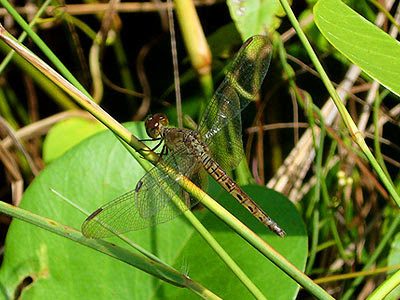

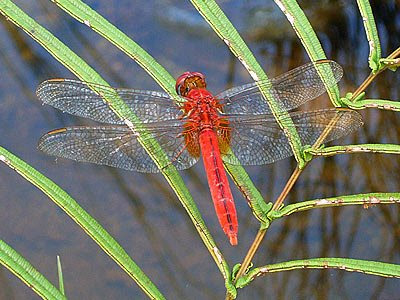

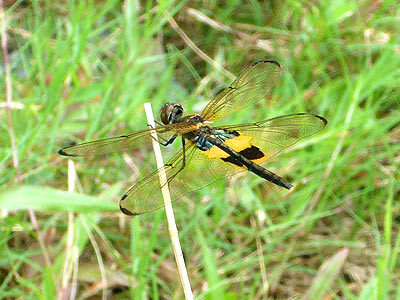


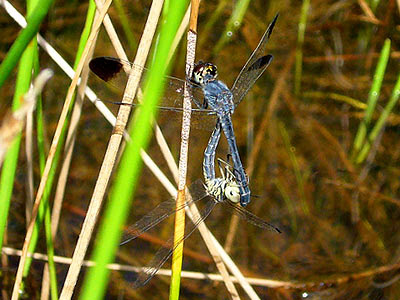

































 Last Sunday, we had a few special guests joining us on our Semakau intertidal walk. Dr Yaacob Ibrahim, Singapore's Minister for the Environment and Water Resources, finally managed to squeeze out some time from his busy schedule to pay us a visit with his family and friends!
Last Sunday, we had a few special guests joining us on our Semakau intertidal walk. Dr Yaacob Ibrahim, Singapore's Minister for the Environment and Water Resources, finally managed to squeeze out some time from his busy schedule to pay us a visit with his family and friends! We started the boat ride all sunny and bright, and just as we were reaching Semakau, it started pouring. Fortunately, the rain stopped when we were about to start the landfill tour.
We started the boat ride all sunny and bright, and just as we were reaching Semakau, it started pouring. Fortunately, the rain stopped when we were about to start the landfill tour. Getting in-touch with nature is just so much more exciting that just watching it on TV!
Getting in-touch with nature is just so much more exciting that just watching it on TV!